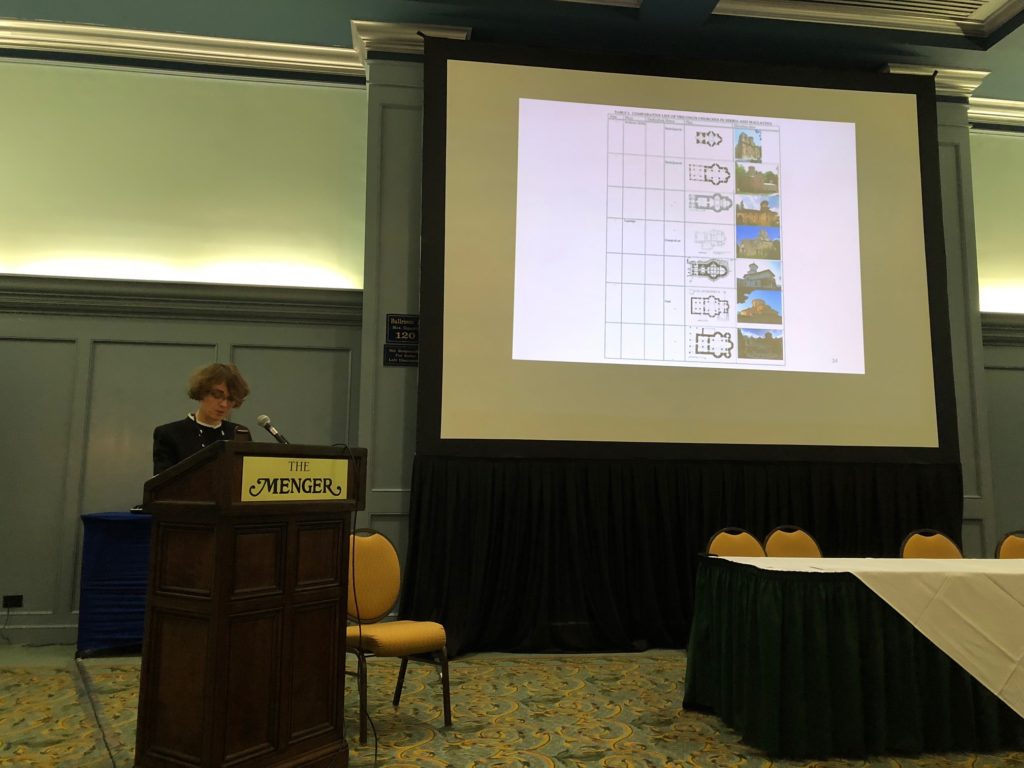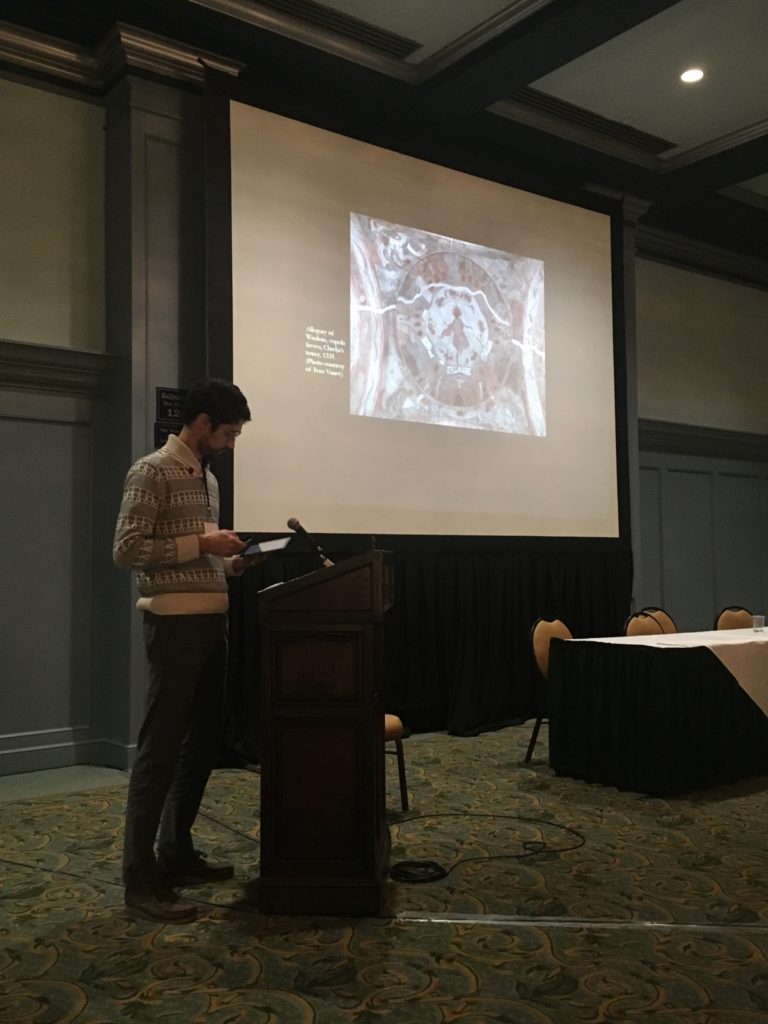-
5-6 April 2019 – SYMPOSIUM – Eclecticism at the Edges: Medieval Art and Architecture at the Crossroads of the Latin, Greek, and Slavic Cultural Spheres

The Symposium “Eclecticism at the Edges: Medieval Art and Architecture at the Crossroads of the Latin, Greek, and Slavic Cultural Spheres” took place on April 5-6, 2019 in McCormick Hall 106 on the Princeton University campus.
In response to the global turn in art history and medieval studies, “Eclecticism at the Edges” explores the temporal and geographic parameters of the study of medieval art, seeking to challenge the ways in which we think about the artistic production of Eastern and East-Central Europe from the fourteenth through the sixteenth centuries. This event serves as a long-awaited platform to examine, discuss, and focus on the eclectic visual cultures of the Balkan Peninsula and the Carpathian Mountains, the specificities, but also the shared cultural heritage of these regions. It raises issues of cultural contact, transmission, and appropriation of western medieval and Byzantine artistic and cultural traditions in eastern European centers, and considers how this heritage was deployed to shape notions of identity and visual rhetoric in these regions that formed a cultural landscape beyond medieval, Byzantine, and modern borders.
The symposium is free, but registration is required to guarantee seating. Please register here: https://ima.princeton.edu/register/
For any queries, please contact the organizers at: eclecticism.symposium@gmail.com.
This event is generously co-sponsored by the following:
- The International Center of Medieval Art
- The Society of Historians of East European, Eurasian, and Russian Art and Architecture
- The Mary Jaharis Center for Byzantine Art and Culture
- The Princeton Institute for International and Regional Studies
- The Department of Art & Archaeology, Princeton University
- The Index of Medieval Art, Princeton University
- The Seeger Center for Hellenic Studies with the support of the Stanley J. Seeger Hellenic Fund
SYMPOSIUM PROGRAM:
Friday, April 5, 2019
McCormick Hall 106
5:00-5:15 Maria Alessia Rossi, Princeton University
Alice Isabella Sullivan, University of Michigan
Welcome5:15-6:30 Keynote Lecture
Jelena Erdeljan, University of Belgrade
Cross-Cultural Entanglement and Visual Culture in Eastern Europe c. 1300-15506:30-7:30 Film Screening and Exhibition
Introduction by Julia Gearhart, Princeton University
“No Woman’s Land”: A 1929 Expedition to Mount Athos and Meteora7:30-9:00 Reception
McCormick HallSaturday, April 6, 2019
McCormick Hall 106
9:00-10:40 Session 1 – New Constructs of Identity
Chair: Charlie Barber, Princeton University
Elena Boeck, DePaul University
A Timeless Ideal: Constantinople in the Slavonic Imagination of the 14th-16th Centuries
Gianvito Campobasso, University of Fribourg
Eclecticism Among Multiple Identities: The Visual Culture of Albania in the Late Middle Ages
Ida Sinkević, Lafayette College
Serbian Royal Mausolea: A Reflection of Cultural Identity?10:40-11:00 Coffee / Tea Break 11:00-12:40 Session 2 – Shifting Iconographies
Chair: Pamela Patton, Princeton University
Vlad Bedros, National University of Arts, Bucharest
A Hybrid Iconography: The Lamb of God in Moldavian Wall-Paintings
Krisztina Ilko, The Metropolitan Museum of Art
The Dormition of the Virgin: Artistic Exchange and Innovation in Medieval Wall Paintings from Slovakia
Ovidiu Olar, Austrian Academy of Sciences
A Murderer among the Seraphim: Prince Lăpușneanu’s Transfiguration Embroideries for Slatina Monastery12:40-2:00 Lunch Break 2:00-3:40 Session 3 – Patronage and Agents of Exchange
Chair: Cristina Stancioiu, College of William and Mary
Dragoş Gh. Năstăsoiu, Centre for Medieval Studies, National Research University “Higher School of Economics,” Moscow
Appropriation, Adaptation, and Transformation: Painters of Byzantine Tradition Working for Catholic Patrons in 14th- and 15th-century Transylvania
Christos Stavrakos, University of Ioannina/Greece
Donors, Patrons, and Benefactors in Medieval Epirus between the Great Empires: A Society in Change or a Continuity?
Nazar Kozak, National Academy of Sciences of Ukraine
Post-Byzantine Art as a Network: Mobility Trajectories of the Akathistos Cycle in the Balkans, the Carpathians, and Beyond3:40-4:00 Coffee / Tea Break 4:00-5:15 Keynote Lecture
Michalis Olympios, University of Cyprus
“Eclecticism,” “Hybridity,” and “Transculturality” in Late Medieval Art: A View from the Eastern Mediterranean5:15-6:00 Roundtable Discussion, Questions, and Closing
Moderator and Respondent: Ivan Stevović, University of Belgrade6:00-9:00 Final Reception
Chancellor Green Rotunda
4-7 October 2018 – Byzantine Studies Conference – Sponsored Sessions
North of Byzantium: Art and Architecture at the Crossroads of the Latin, Greek, and Slavic Cultural Spheres, c. 1300 – c. 1550
Byzantine Studies Conference / 4-7 October, 2018 / San Antonio, Texas
SPONSOR: Mary Jaharis Center for Byzantine Art and Culture
SESSION 1
Speakers: Jelena Bogdanovic, Ph.D.
Associate Professor of Architectural History and Theory, Iowa State University
Triconch Churches Sponsored by Serbian and Wallachian Nobility, ca. 1350s–1550s
Alice Isabella Sullivan, Ph.D.
Lecturer, Department of History of Art, University of Michigan
Cultural Interactions in Moldavian Art and Architecture
Henry Schilb, Ph.D.
Index of Medieval Art, Department of Art & Archaeology, Princeton University
Mutual Peripheries: Differentiating between the Byzantine Traditions of Wallachian and Moldavian Embroideries
SESSION 2
Speakers: Ida Sinkevic, Ph.D.
Professor of Art History, Lafayette College
Dečani Between East and West
Maria Alessia Rossi, Ph.D.
Index of Medieval Art, Department of Art & Archaeology, Princeton University
Early Fourteenth-Century Serbian Monumental Painting: Continuation or Rupture with Byzantium?
Justin L. Willson, Ph.D. Candidate
Department of Art and Archaeology, Princeton University
The Allegory of Wisdom in Hreljo’s Tower (1335) seen in light of Philotheos Kokkinos’s Discourse on Wisdom






